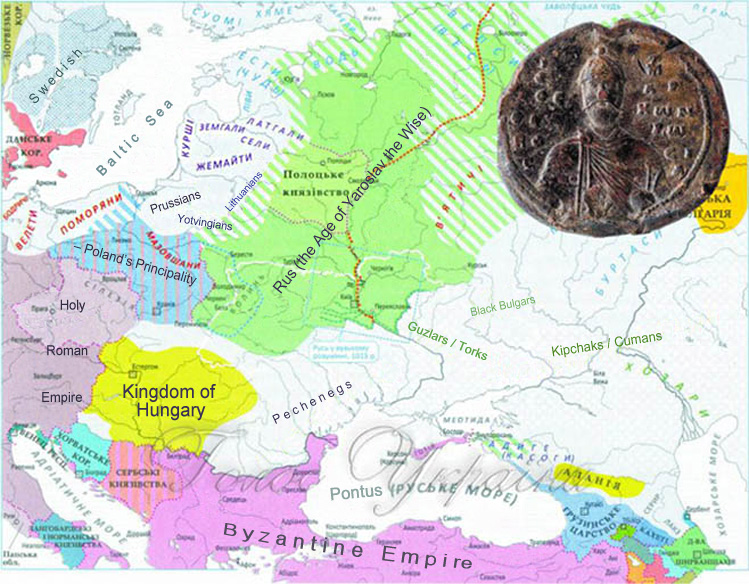Photo. The Map of the Rus State at the times of Yaroslav the Wise. Source: «Terra Ucrainica. Історичний атлас України і сусідніх земель». At the upper right, the Seal of the Grand Prince Yaroslav the Wise of Kyiv
The main goal of this stereotype cherishing is to dictate the idea that Ukraine is the natural part of “the Russian World” and the Ukrainian lands are Little Russia (Malorossiya or Malorosiia) originated as a colony from homeland of Russia.
However, the true story is quite different. The notion of Little Rusiia (Mala Rus) dates back to the 14th century.
In 1303, the Patriarchate of Constantinople agreed the establishment of the Halycian Orthodoxy Metropolis which was a pursuit of Yuri I of Halytsia (Galicia), the grandson of Danylo of Halytsia, since this could strengthen his own kingdom as the Kievan Inheritance. Also it was how the Patriarch of Constantinople reacted to the relocation of Maximus, the Metropolitan of Kiev, to Vladimir on the Klyazma River. The former Rus State obeyed to Halytsian metropole, which was named Little Rus or Little Rosiia in a way similar to the correlation between Graecia or Mother-Land Greece and its extension into colonies called Magna Graecia. Mother-Land Greece was regarded by the Patriarchate as the territory of the origin and the cradle of ethnos, the point from where the Greek social, economic and cultural expansion began. This resulted in the emerge of Magna Graecia. Consequently, Little Rosiia stood for initial; the another example of a similar term can be considered the one of Polonia Minor or Lesser Poland (should not be confused with the modern Lesser Poland Voivodeship). Great Rosiia is the legacy of territorial expansion of Little Rosiia. Since the 14th century, the term of Little Rosiia acquired the form of Mala Rus and referred to Halytsian-Volynian (Galicia-Volhynia) Principality or Regnum Rusiae including Kyiv while Great Rosiia was the land with an administrative center in Vladimir on the Klyazma River and later Moscow. Gradually, the name of Mala Rus, the notion of purely church field, penetrated into the political sphere. Thus, in the 1330s, prince Yurii II Boleslav introduced the component of Mala Rus into his title, while Nicephorus Gregoras, the Byzantine historian, made records in his works that there was the state of Mala Rus with the centre of Kyiv.
In the 16th – 17th centuries the Ukrainian religious leaders (H. Balaban, M. Rohoza, Y. Boretskyi (J. Boretsky), P. Mohyla) had to apply to the Muscovy state for the support to resist the religious pressure imposed by the Rzeczpospolita government since the Patriarch of Constantinople was not capable of protective reassuring for the Ukrainian Orthodox church. In order to represent the ask for the protection to the Muscovy tsar in the manner able to attract the attention, they applied to the idea of relativeness between the two Ruses, the Little Rosiia and the Great Rosiia, which both had once been ruled by the power of the Kyiv Prince. However, the issues discussed were only about the supportive engagement but not about the uniting. In particular, during concluding the Pereiaslav Treaty (Pereyaslav Treaty) in 1654, the metropolitan of Kyiv, Sylvester Kosiv (Kossów) refused to recognise the power of the Muscovy tsar over the Metropolis of Kyiv.
During the Cossack-Polish War (1648 – 1657), the New Ukrainian Cossack nobility was making efforts to establish themselves in power and was relying on the tradition of the ancient Rus in the pursuit of the international recognition for the state of the Zaporozhian Host or Hetmanate. For this purpose, they widely applied the name of Mala Rus or Little Rus in the international scene in order to legitimise their political and social claims for the Ukrainian lands as they were those who were the heirs of the old Rus state. In the same way, it was stated that “Hetmanate is Mala Rus today”. In 1651, I. Vyhovskyi (I. Vyhovsky), the secretary-general or chancellor, was negotiating with the Muscovy ambassadors and said that the Muscovy tsar should take under his care “the whole Mala Rus”, based on the Treaty.
The names of Mala Rus and later Malaia Rossiia were widely used by the Cossack nobility and was identical to the name of Ukraina (later Ukraine), determining all the territory under the control of Cossack hetmans at the time of I. Vyhovskyi and K. Rozumovskyi (K. Razumovsky). Moreover, the hetmans used to attribute the name of Malaia Rossiia to all the Ukrainian lands not only to the Livoberezhna Ukraine (Left-Bank Ukraine), which were apparently under their control. Thus K. Rozumovskyi claimed that he was “the hetman of Malaia Rossiia of the both banks of the Dnieper River”.

Eventually, the name of Mala Rus originally referred to the territory which was the subject to the Church’s authority on the lands of Rus (Kievan Rus) and only later this name acquired the political meaning. Mala Rus was considered as the very land to initiate the spread the Church’s authority and the state power to those lands which were later called as Great Rosiia. From the middle of the17th century, the Muscovy rulers had been trying to distort the grounds of these names, claiming that the existence of Great Rossiia allowed its piece of Mala Rus (in contemporary translation Mala is Little) to break apart so that the Muscovy Tsar and further the Russian Emperor had the power over the all lands of both Little Rossiia and Great Rossiia (later Russia).
However, the rulers managed to impose on Ukraine and Europe this imperial vision of the picture of Rus only in the 19th century, that was the time when almost entire Ukraine was occupied by the Russian Empire. Since that time the notion of Mala Rus (Malaia Rossiia, Malorosiia) and the Maloros or the Malorus acquired the different form to suit the concept of three-united folk – the Great Russians – the Malorus – the Belarusian. This speculative theory regarded Malorosiia (Little Rossiia) as the part of Great Rossiia while the Maloruses were called the natural part of the Great Russian folk. The supporters of this theory manipulate with the stereotypical thinking of the human, as people used to accept ‘little’ as that derived from ‘great’. Subconsciously, the person is lead to the conclusion that Little Rosiia/ Russia is the part of Great Rossiia/ Russia. That is how the situation was understood by the intellectuals since the 17th century.
Further, in the 19th century, the new Ukrainian nobility gradually abandoned the names of Malorosiia (Little Rosiia) and the Malorus in favour of the notion of Ukraine as they wanted to avoid the impression of being the second best in the forced paradigm of Great Russia - Little Russia.
The current publication is based on the research of the Ukrainian Institute of National Remembrance and quotes of the book by V. Brekhunenko (Брехуненко В. Війна за свідомість. Російські міфи про Україну та її минуле.‒ К., 2017.‒ 280 с.)
Our advice to read:
1. Брехуненко В. Війна за свідомість. Російські міфи про Україну та її минуле.– Київ: Віпол, 2017.– 279 с.: іл., карти.– Бібліогр.: с. 254–275.
2. Брехуненко В. Україна й українці. Ім'я як поле битви.– Київ: [б. в.], 2020.– 272 с.: іл., карти, фот.
3. Моця О.П. «Русь», «Мала Русь», «Україна» в післямонгольські та козацькі часи.– Київ: Наукова думка, 2009.– 320 с.
Our advice to watch:











